Don't wanna be here? Send us removal request.
Text
Wool-Carder Bees: these solitary bees harvest the soft, downy hairs that grow on certain plants, rolling them into bundles and then using the material to line their nests
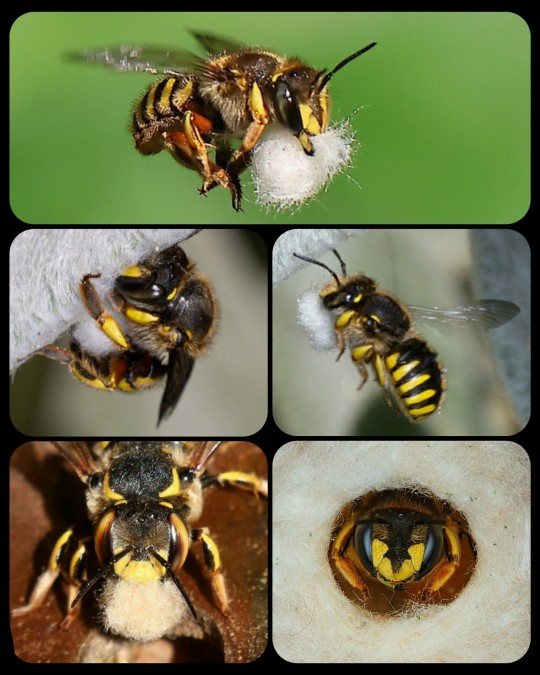
Wool-carder bees build their nests in existing cavities, usually finding a hole/crevice in a tree, a plant stem, a piece of rotting wood, or a man-made structure, and then lining the cavity with woolly plant fibers, which are used to form a series of brood cells.
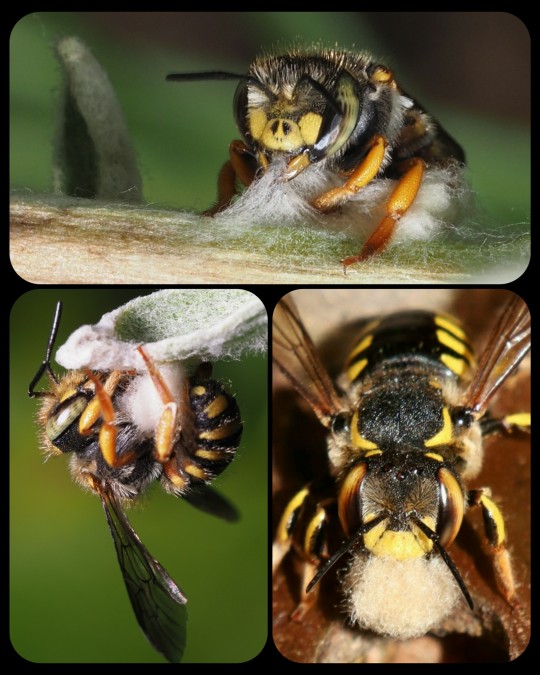
The fibers (known as trichomes) are collected from the leaves and stems of various plants, including lamb’s ear (Stachys byzantina), mulleins, globe thistle, rose campion, and other fuzzy plants.

From the University of Florida's Department of Entomology & Nematology:
The female uses her toothed mandibles to scrape trichomes off fuzzy plants and collects a ball of the material under her abdomen. She transports these soft plant fibers to her selected nest site and uses them to line a brood cell. Next, she collects and deposits a provision of pollen and nectar into the cell, enough pollen to feed a larva until it is ready to pupate. Lastly, she lays a single egg on top of the pollen and nectar supply before sealing the cell. ... She will repeat this process with adjoining cells until the cavity is full.
These are solitary bees, meaning that they do not form colonies or live together in hives. Each female builds her own nest, and the males do not have nests at all.
Female wool-carder bees will sometimes sting if their nest is threatened, but they are generally docile. The males are notoriously aggressive, however; they will often chase, head-butt, and/or wrestle any other insect that invades their territory, and they may defend their territory from intruders up to 70 times per hour. The males do not have stingers, but there are five tiny spikes located on the last segment of their abdomen, and they often use those spikes when fighting. They also have strong, sharp mandibles that can crush other bees.
There are many different types of wool-carder bee, but the most prolific is the European wool-carder (Anthidium manicatum), which is native to Europe, Asia, and North Africa, but has also become established as an invasive species throughout much of North America, most of South America, and New Zealand. It is the most widely distributed unmanaged bee in the world.

A few different species of wool-carder bee: the top row depicts the European wool-carder, A. manicatum (left) and the spotted wool-carder, Anthidium maculosum (right), while the bottom row depicts the reticulated small-woolcarder, Pseudoanthidium reticulatum, and Porter's wool-carder, Anthidium porterae
Sources & More Info:
University of Florida: The Woolcarder Bee
Oregon State University: European Woolcarder Bees
Bohart Museum of Entomology: Facts about the Wool Carder Bee (PDF)
Bumblebee Conservation Trust: A. manicatum
World's Best Gardening Blog: European Wool Carder Bees - Likeable Bullies
Biological Invasions: Global Invasion by Anthidium manicatum
3K notes
·
View notes
Text
Bog Turtles!
▪︎ Contribution: I'm obsess with these turtles, the Eastern Bog Turtle is found where I live and I'm constantly looking for them on my commute. Most turtles are endangered or vulnerable species on the Eastern Coast of America and they are especially vulnerable on roads and highways. If you can safely stop for a turtle, you should take it and leave it somewhere safe. Then, take pictures of it and see if there is an ecological program at the local college, or facebook group. Document their location and take identifying photographs of the top and side:


(Image Source 1, Image Source 2)
If it is an eastern bog turtle, you need to call your local university's biology program so they can relocate the turtle to a protected area.
North Carolina State University has a emergency free medical service for turtles hit by cars. Box Turtles car injuries have been increasing with a huge rate due to environmental encroachment and deforestation. Bog Turtles are rarer than some Rhino species, as North Carolina has drained 98% of their bogs for urbanization.
Here is Nature.Org's article about Bog Turtles.
◇ Here is a video from NC PBS about Bog Turtles! ◇
youtube


Bog Turtles (Glyptemys muhlenbergii), family Emydidae, New Jersey, USA
CRITICALLY ENDANGERED.
Found only in bogs and other calcareous wetlands in the NE United States.
photographs by Mike Knoerr (B) and Joe Pignatelli (T)
#turtle#bog turtle#glyptemys#emydidae#reptile#herpetology#north america#animals#nature#animal conservation#tumblr post#video post#contribution post#endangered species#resource link post#north carolina state university#NC Sci#Youtube
498 notes
·
View notes
Text

I often hear that house centipedes have “too many legs” from people who aren’t as fond of all the Appendage as I am.
however, did you know that they aren’t born with all those legs?

this little bug nugget is an hours-old baby house centipede, with only 4 legs to her name!

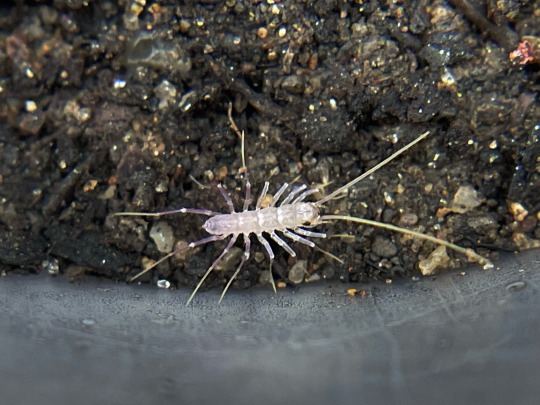
as she grows, she’ll add a pair or two each time she molts her exoskeleton, until she reaches 15 pairs in the sequence 4-5-7-9-11-13-15. the purple capsule at her butt is a legless segment where the new ones will come in when they’re ready!

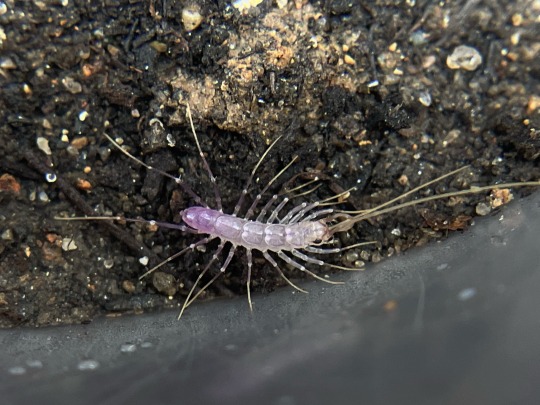

house centipedes can grow all their legs in just one summer, but will probably not be sexually mature for another year or two. since they keep slowly molting and growing after adulthood, some of the huge, ancient ones you see might be over 5 years old—what secrets the elder basement fairies must know, gleaned from cobwebs and crevices
9K notes
·
View notes
Text
■thought: every single day, every single second, someone is working tiredlessly to govern our planet, our beautiful home, and keep it safe. From the farmers planting the green wall in Africa keeping the desert as bay to the researchers breeding wasting disease-resilient plants and animals indistinguishable from their vulnerable grandparents in order to keep them safe, thank you. There is and always will be someone. I pray that one day, it can be everyone.
"It's like underwater gardening," said Lea Verfondern, 21, a veterinary assistant who was part of the first batch of citizens to attend the training in early July.
"Everyone should make a contribution to protecting the environment because it... affects us all," said Verfondern, before donning a full wet-suit with a hood.

Seagrasses store more than twice as much carbon from planet-warming carbon dioxide (CO2) per square mile than forests do on land, according to a 2012 study. The plants also help support fisheries and protect coasts from erosion.


While there are other initiatives to restore the plants worldwide, the SeaStore Seagrass Restoration Project in Kiel, run by the GEOMAR Helmholtz Centre for Ocean Research, is one of the first that aims to enable citizens to do so autonomously.
Verfondern, 6 other divers and some land volunteers planted some 2,500 plants during the weekend course in July.

#tumblr post#news article#reuters#environment#baltic sea#ecosystems#ecoconservation#sea grass#climate change
138 notes
·
View notes
Text
■thought: While the larve may cost some crop loss due to their appetites being similar to ours with their love of tublars and roots and occasionally leaves of crop plants, the adult Crane Fly does not have mouth parts to drink blood or inject venom, nor do they consume mosquitoes (like the nicknames "Mosquito Hawk"or "skeeter eater" implies).
■contribution: From the Article "What Eats Crane Flies: The Intriguing Predator Unveiled" by Daniel Marlos Piyushi Dhir-
"Crane flies may look intimidating, but they’re often a misunderstood outdoor critter. You may have encountered these large, mosquito-like insects in your yard and wondered about their role in the ecosystem. Knowing what eats crane flies can help us appreciate their place in the natural world and can give us a better understanding of how these fragile creatures fit into the food web.

In the wild, crane flies play an essential role in the food chain, serving as a valuable food source for various creatures ranging from birds to amphibians. By understanding the dietary preferences of these predators, you can gain a better appreciation for the intricate relationships between different species and the balance that exists in nature.

For instance, common predators of crane flies include birds like robins and swallows, which feast on both adult crane flies and their larvae. Frogs, toads, and even some spiders may also snack on these insects, helping control their population and ensuring that the delicate ecological system maintains equilibrium. Overall, understanding what eats crane flies leads to a better appreciation for the interconnectedness of our natural world."
■thought: Mosquitoes have a bad wrap. Of the 3000 some odd species of Mosquitoes, less than 2% of them drink blood, and less than half of those drink human blood, and are considered disease vectors. Those Mosquitoes, like Aedes aegypti, or the Yellow Fever Mosquito for example, have done so much damage to the public relations of anything Mosquito-like, that even the harmless and important Crane Fly suffers, despite the resemblance being almost non-existent (its not even a mosquito!). Below is a picture of Aedes aegypti:


When being outside, you may encounter an animal that scares you or creeps you out. It's okay to be afraid of things that you do not know about, and easier still to not have compassion with something that can look so alien. Crane flies and their family were born on earth over 245 million years ago- they're the oldest family of flies ever to exist! That makes them a bonafide Earthling 😊
They, and all other animals on earth, deserve to be here just as much as we do. Their time on earth is finite and precious, just like ours. They are just animals who look scary to us because they are so fragile and easy to harm. I personally consider them to be similar to faeries. 💜

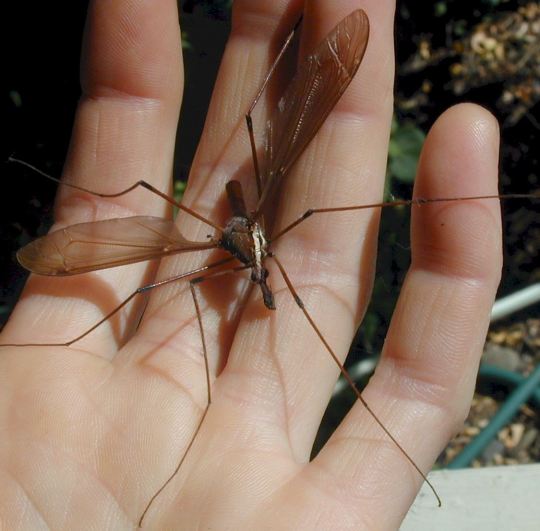
#tumblr post#animals#contribution post#tumblr poll post#crane fly#Mosquito hawk#Tipuloidea#love thy neighbor#leatherjacket#skeeter eaters
22K notes
·
View notes
Text
■thought: we live in a beautiful world. I hope one day we can all see the similarities in each other as well.
Kinda in love with the idea that different places on other sides of the world can look so similar. Something something universal human experiences
86K notes
·
View notes
Text
■contribution: From an article by Kaushik Patoway for Amusing Planet-
Large herbivores such as elephants often seek out natural mineral deposits such as rocks and soil to supplement their dietary intake of sodium whenever the mineral is not obtained in adequate quantities from woody plants and natural water which elephants consume. So it is not uncommon to find elephants devouring soil and licking rocks high in sodium content. In Mount Elgon National Park on the Kenya-Uganda border, elephants have taken this activity a step further—they have learned to quarry sodium-rich rocks on the base of a 24-million-years-old extinct volcano called Mount Elgon.

Mount Elgon is believed to be the oldest extinct volcano in East Africa. Because of its unusually large form—an 80 kilometer wide base and a peak that rises 3,000 meters from the surrounding plains— Mount Elgon doesn’t have the typical sharp rise of a volcanic mountain. The rise is more gradual, and as the land rises the vegetation changes and so does the climate. The forest becomes thicker and air becomes chilled. Many rare plants and animals seek shelter in the higher slopes of Mount Elgon to escape the heat of the plains.
The elephants prefer to stay in the lower slopes where there are a number of caves and salt is plenty. These caves are quite voluminous, with up to 150 meters long, 60 meters wide, and some 10 meters high. There is evidence that these caves have been artificially expanded by thousands of years of mining—not by humans, but by the pachyderms.

The elephants use their tusks to break off pieces of the cave wall, which they then chew and swallow, leaving long scratch marks all over the cave walls. The elephants chisel the rocks for several hours and eat large quantities of salt at a time, since they usually do not return until several weeks later. The elephants have a voracious appetite for salt. One young bull elephant at the Aberdare National Park in Kenya was observed to consume 14 to 20 kg of salty soil in 45 minutes. From another observation of a young calf feeding himself rocks inside Kitum Cave in Mount Elgon, researchers estimate that on average an elephant excavate about two liters volume of rocks from the cave.

Illustration credit: Ian M. Redmond
Aside from elephants, other animals such as bushbuck and buffaloes are also drawn to the salt in the caves. It’s unlikely the animals know they need salt in their diet. The behavior is mostly instinctive, developed over thousands of years, and by leading their young into the caves, the knowledge has been passed on through the generations.
Some predators such as leopards and hyenas take advantage of this behavior by hiding in the darken interior of the caves and attack weaker animals such as elephant calves, buffaloes and bushbucks. The worst happened during the 1980s when poachers discovered this trick. They hid near the entrance to the caves and ambushed the elephants as they approached. From more than 1,200, the population of Mount Elgon's elephants fell to under one hundred. Poaching radically altered the behavior of the elephants—they became more secretive and started avoiding the better-known caves.

The fall in ivory prices in the 1990s and a more determined anti-poaching effort by the Kenyan government gave the elephants some respite. The situation has improved since the last two decades, but the future is anything but bright.

Tusk marks on the wall of the caves.
■thought: From the time I was a child and heard the phrase "an elephant never forgets" to seeing the videos in my early adulthood of the parade of mourning elephants gently stroking the bones of their long lost loved one, elephants have been an animal that I have a strong connection to and feel very strongly about. Knowing whole structures have been carved out of ancient rock by this specific parade brings me much joy. What other animal structures exist out there? What else are elephants capable of knowing and doing? What does this mean regarding the conservation efforts for these wizened, leathery giants? So much appreciation to the conservationalists studying these amazing members of our Earth family.
If you would like to know more about Mount Elgon National Park and Kitum Cave, their website can be found here.
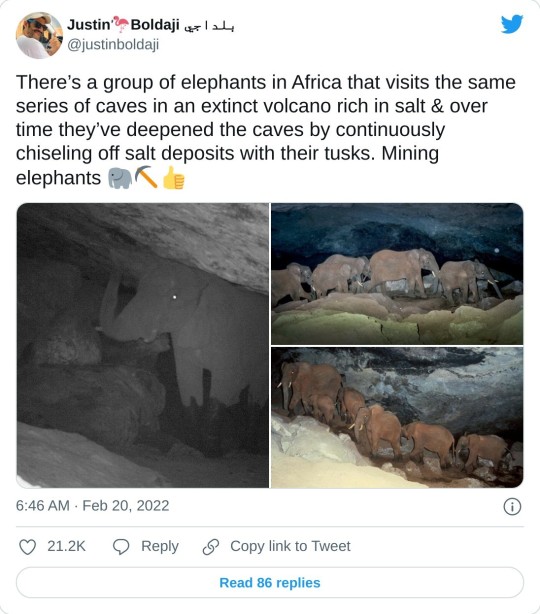
View on Twitter
These pictures are killing me


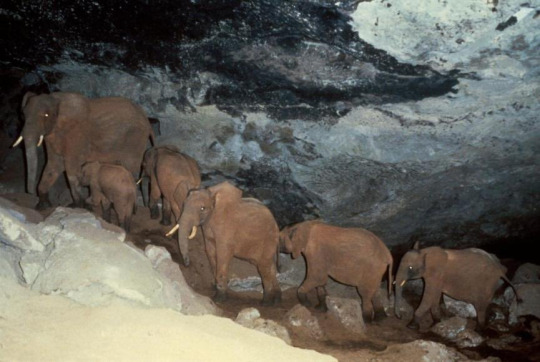
#tumblr post#twitter post#tumblr text post#animals#animal behavior#contribution post#Elephants#Africa#Kenya#Mount Elgon#Kitum Cave#east africa#animal conservation
181K notes
·
View notes
Photo
■thought: when I look at this map, it reminds me that within each of those blocks could be dozens if not hundreds of individual microsystems and habitats with animals, plants, mushrooms, and human culture endemic to only that place on earth. Each square inch is precious and needs to be protected and celebrated- could you imagine a world with no color, only concrete?
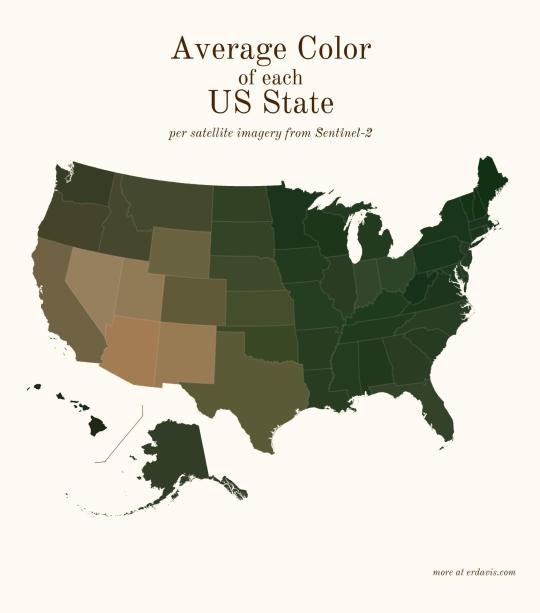
Average color of US states based on satellite imaging.
111K notes
·
View notes
Text
■thought: some people will look at this animal and believe that it is a step in evolution, and it is easy to see why, but it is untruthful to the animal and its history. This animal fills a specific space in its environment, and has adapted over millions of years to be exactly how they are. And they do it swimmingly. 😊
■contribution:

https://www.livescience.com/32668-discovery-reveals-how-fish-learned-to-walk.html
What an amazing neighbor we have!

Leaping blennies
Need a boost this Monday? Well, here's a dash of motivocean for you! Leaping blennies are amazing amphibious fish. They can launch themselves off of rocks into the air sometimes up to 50 times their body length! Not only do they flash their red dorsal fins to communicate, but they can also live on land temporarily in tide pools and rocky coasts. These extraordinary terrestrial fish shore know how to make a splash, both in and out of the water! 💦💪


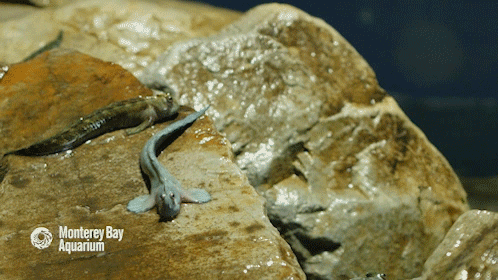
#montereybayaquarium#tumblr post#tumblr video post#video post#contribution post#animal#fish#leaping blennies#pacific ocean#animal behavior
2K notes
·
View notes
Text
■thought: it would be something extraordinary to find life on mars, but it would be lifechanging if we found life on venus. Imagine how beefed up those tardigrades would be living in an unimaginable atmosphere in such intense heat conditions unseen on planet earth. Now if only the lense cap would let us investigate! 😁♀️
So Venus is my favorite planet in the solar system - everything about it is just so weird.

It has this extraordinarily dense atmosphere that by all accounts shouldn't exist - Venus is close enough to the sun (and therefore hot enough) that the atmosphere should have literally evaporated away, just like Mercury's. We think Earth manages to keep its atmosphere by virtue of our magnetic field, but Venus doesn't even have that going for it. While Venus is probably volcanically active, it definitely doesn't have an internal magnetic dynamo, so whatever form of volcanism it has going on is very different from ours. And, it spins backwards! For some reason!!
But, for as many mysteries as Venus has, the United States really hasn't spent much time investigating it. The Soviet Union, on the other hand, sent no less than 16 probes to Venus between 1961 and 1984 as part of the Venera program - most of them looked like this!

The Soviet Union had a very different approach to space than the United States. NASA missions are typically extremely risk averse, and the spacecraft we launch are generally very expensive one-offs that have only one chance to succeed or fail.
It's lead to some really amazing science, but to put it into perspective, the Mars Opportunity rover only had to survive on Mars for 90 days for the mission to be declared a complete success. That thing lasted 15 years. I love the Opportunity rover as much as any self-respecting NASA engineer, but how much extra time and money did we spend that we didn't technically "need" to for it to last 60x longer than required?
Anyway, all to say, the Soviet Union took a more incremental approach, where failures were far less devastating. The Venera 9 through 14 probes were designed to land on the surface of Venus, and survive long enough to take a picture with two cameras - not an easy task, but a fairly straightforward goal compared to NASA standards. They had…mixed results.
Venera 9 managed to take a picture with one camera, but the other one's lens cap didn't deploy.
Venera 10 also managed to take a picture with one camera, but again the other lens cap didn't deploy.
Venera 11 took no pictures - neither lens cap deployed this time.
Venera 12 also took no pictures - because again, neither lens cap deployed.
Lotta problems with lens caps.
For Venera 13 and 14, in addition to the cameras they sent a device to sample the Venusian "soil". Upon landing, the arm was supposed to swing down and analyze the surface it touched - it was a simple mechanism that couldn't be re-deployed or adjusted after the first go.
This time, both lens caps FINALLY ejected perfectly, and we were treated to these marvelous, eerie pictures of the Venus landscape:

However, when the Venera 14 soil sampler arm deployed, instead of sampling the Venus surface, it managed to swing down and land perfectly on….an ejected lens cap.
#tumblr post#text post#tumblr text post#outer space#not of earth#sister sky#venus#environment#astronomy#soviet imagery
28K notes
·
View notes
Text
youtube
■contribution: Here is an informative video about the relationship the earth has with its sky and how important it is to reclaim our skies at night from sky glow and wasteful light pollution. Whole urban cities now are dimming their lights protecting bird migration, insect populations, and urban plant health.
■thought: It's really simple. Email, call, or send a letter to your governing body. Join town meetings and stay tenacious. It saves money, still keeps people safe with light shielding, and would let the 80% of people (in America) be able to see the stars again. Having grown up in the mountains away from other people and light pollution, I feel like seeing the night sky and our beautiful solar system is a right for every person and animal that exists.
perhaps some will disagree, but i think the world got worse when we changed the colour of the night
#tumblr post#video post#contribution post#environment#human impact#dark sky movement#urban planning#sky glow#light pollution#migration patterns#animal behavior#birds#Youtube
279K notes
·
View notes
Photo
■thought: Bees are one of my favorite animals, not just because of their industrious nature or how much I love honey, but because they show us how strong a collective can be against those who threaten to harm their home. Alone, a single bee cannot do much except give her life with a single sting, but together, bees can scare away animals as large as bears away with enough tenacity and cooperation.

Giant honeybees live in huge open nests. To protect themselves, they’ve developed a mesmerizing wave-like defense known as shimmering. When shimmering, the bees in a hive, beginning from a distinct spot, will flip over to expose their abdomens. Taken together, this creates large-scale patterns like those seen above.
Scientists have connected the behavior to the presence of wasps that prey on the bees. It seems that shimmering helps to repel the wasps without putting individual bees in danger. If shimmering doesn’t ward off the wasps, the bees can also use their flight muscles to heat the area around the intruder to a wasp-lethal temperature – or, individuals bees can sacrifice themselves by stinging the wasp. (Image credit: Beekeeping International, source; research credit: G. Kastberger et al.; via Gizmodo)
This post is part of our series on collective motion. Check out our previous posts about how crowds are like sand, the fluid properties of worms, and why a lack of randomness makes predicting group behaviors hard.
#tumblr post#tumblr gif post#animals#insects#bees#giant honey bees#animal behavior#defense mechanisms#hive collectivism
1K notes
·
View notes
Text
■thought: I think I would pass out from this experience. Whales are so valuable and important to the ecosystem, to see that these expecting mothers are so gentle and curious of human beings takes my breath away. 🐋🩵
#tumblr post#Argentina#animals#family#human animal interaction#animal behavior#southern right whale#video tumblr post#cephalopod
112K notes
·
View notes
Text
Hello! Welcome to my blog, which is a focus of fun, educational videos I have found about nature! Including conservationalism, animals, habitats, and natural sciences!
There is a list of tags so that you may be able to find a focus that you are interested in, too!:

Note, I am not a scientist, I just have a love of all things great and small! There will be a focus of Appalachia in the US because that is where I am from and the place I love most on earth!
Formats:
#text - any interesting and fun text post from my feed on Tumblr!
#video - video media, will most likely be links to a youtube video! If I can I will try to supply multiple links to the same video.
#documentary - longer form video media, for those who want to snuggle in (>25 minutes long usually!)
#article - off site publication of any interesting and cool thang!
#art - infographs, poetry, and any other educational piece that catches the eye.
Contents:
Posts focusing on a species will have #Animal, #Plants, #Mushrooms, etc. as well as anything specific (for example, if a video is about the Panda Bears mating habits, it will have the tags #video, #Animal, #Panda Bear, #reproduction, #animal mating habits, #conservation #endangered species).
Posts of about environments and how cool and unique they are will have #Nature, #Country, #Region and the educational focus. (For example, a video about how climate change is affecting the rainfall of Oklahoma, it will have the tags #video, #Nature, #United States, #Oklahoma, #Great Plains, #weather, #meteorology, #rain, #climate change).
Posts about Anthropology and human history will always have the tag #Family
Should anyone have any questions, I will try my best to answer them. Anyone is free to message me or comment my posts if they wish to talk about the amazing planet that we call home!
0 notes